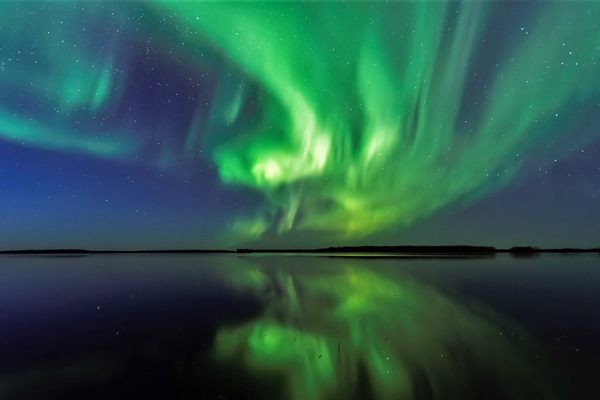Why Are There Three Twilights?
And we’re not talking about vampire books.
When the sun slides out of sight—or, more accurately, when Earth rotates so that your particular place on the planet is no longer exposed to our day star—but before darkness consumes the landscape, there is the magical, muted time of twilight.
The word comes to us from the Old English twyelyghte, or half-light, when the vivid colors of the day fade to a shadow palette of grays. Of course, the colors don’t change, but our ability to discern them does. Most animal eyes have a mix of rods and cones, light-sensitive cells that provide information to the brain about either light (rods) or color (cones). The bespoke blend for each species depends on its particular niche in the ecosystem: Nocturnal animals, such as owls, have a significantly higher ratio of rods to cones in their retinas to make the most of the night’s limited light. Humans and other diurnal animals generally have more cones, which need more light to work. So, as daylight fades, the rods in our retinas, which cannot detect color, continue to tell our brain about the shapes of things, but our cones shut down, and color leaches from our vision.
Most of us think of twilight as a single period of transition from bright day to deep night, but there are actually three twilights: civil, nautical, and astronomical. Each is defined by how far below the horizon the sun is, and hint at our lives before artificial light and GPS.

Civil twilight has nothing to do with being polite; it’s simply the evening’s first twilight, which starts at sunset: the moment when the sun’s center is exactly at the horizon or, to get technical, 0 degrees below it. Since the early 19th century—and possibly even earlier—civil twilight has defined the period after sunset when both work and recreation are possible without the need for artificial light, including candles or lanterns. It’s also sometimes defined as the twilight when you can still read outdoors, which sounds very civil to us, indeed.

Once the sun is 6 degrees below the horizon, nautical twilight arrives. If you’re not a degrees kind of person, hold your arm out to the horizon, with your hand turned so your palm is facing the horizon and your fingers, parallel to the horizon, are together but extended. Close one eye. The width of your first three fingers is roughly 5 to 6 degrees, depending on the size of your hand. During nautical twilight, even though it’s well after sunset, there is still a fair amount of light in the sky thanks to our atmosphere, which allows rays to bounce off it like a trampoline.
While the mathematical dividing line between civil and nautical twilight is specific, it may not be readily apparent to the naked eye—unless you’re a mariner. The brightest stars and visible planets that can be seen during and even before civil twilight are joined by a multitude of other celestial bodies that can be used for navigation. However, during this period, a sailor at sea can still see the all-important horizon—that division between water and sky that’s a critical part of calculating location when no landmarks are available. Nautical twilight is the period after sunset when, though no longer able to read a chart without a lantern or torch, sailors could still take accurate readings.
Intriguingly, it’s not just humans who perceive different twilight periods. Scientists have found that different species of migratory birds choose to begin their nightly travel during a particular twilight. Common nighthawks prefer to take to the skies during civil twilight, for example, while nautical twilight is popular with thrushes.

The final twilight, when the sun is 12 to 18 degrees below the horizon, is astronomical twilight. It’s perhaps the most nitpicky of twilights, unless you are an astronomer or serious astro-enthusiast. Most of us, especially in light-polluted cities, would consider this period to be nighttime. Even in rural or wild areas, the horizon is no longer visible. If you’re somewhere without much artificial light, you’ll be able to see most celestial objects of interest to the casual stargazer. However, even though the sun is well below the horizon, a tiny bit of its light still reaches wherever you are during astronomical twilight, pinballing off molecules of air, water, and gas in the atmosphere. It’s not much light, but it is just enough to wreck astronomical observations of fainter stars, galaxies, and nebulas. Once the sun is 18 degrees below the horizon or lower, night reigns.
Whether strictly defined by degrees or simply by what our eyes see, the length of each twilight varies wildly based on latitude, thanks to the same axial tilt of the planet that gives us seasons. The closer you are to the equator, the faster day transitions to night, usually in not much more than an hour or two year-round. However, at higher latitudes, the sun’s goodbye gets longer in summer (and shorter in winter). In polar regions, after the ceaseless light of summer, a gloomy, ever deeper blue-gray trio of twilights lingers for weeks before fading to black.
What goes around comes around, as they say, and as Earth rotates you back to the sun, the period you might call predawn or daybreak is actually the three twilights happening again, in reverse order. This means that, every day (or every night, if you prefer), we experience three twilights twice, for a total of six. And not a vampire among them.











Follow us on Twitter to get the latest on the world's hidden wonders.
Like us on Facebook to get the latest on the world's hidden wonders.
Follow us on Twitter Like us on Facebook